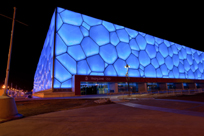architecture
Any number of the projects we've worked on through the years have given us at Root Design Company (Austin, Texas) the sense of pride and satisfaction that comes with doing the big jobs well. Only a handful, however, rise to another level and foster a sense of accomplishment, thereby making what we do both fun and entirely special. The project covered here is one of those amazing exceptions. It came to us through the architect, Arthur Andersson of Andersson-Wise Architects (also based in Austin), which is well known locally for its daring contemporary homes and commercial structures. In this case, the architect had suspended a modern home on a steep slope overlooking Lake Austin. It had a distinctly bare-bones, utilitarian look about it, distinguished mainly by an unusual, inverted-butterfly roofline. His ideas about the swimming pool were ambitious, to say the least. The drawings called for an elevated, cantilevered lap pool constructed entirely of clear panels – a bold statement that would simultaneously harmonize with the stark simplicity of the house itself. The slope on which this was to happen was quite severe, meaning the home itself is
Article: Learn more about the Beijing National Aquatics Center (the “Water Cube”) from Wikipedia. Click here. Video: Watch a CNN interview with
Back in 1949, a prominent couple living in Litchfield County, Conn., decided they wanted to build a contemporary-style home that would stand out among the classically styled residences that marked the area. After conducting extensive research, they retained the renowned Bauhaus architect and Modernist artist Marcel Breuer. The home Breuer eventually designed for Leslie and Rufus Stillman pays testimony to the stark beauty of minimalism: The daring, box-shaped, two-level structure featured an array of contemporary elements and appointments, not least of which is a large, rectilinear swimming pool accessed by a dramatic, cantilevered staircase from the home’s upper level. (Things worked out so well here, by the way, that this was just the first of three Breuer homes commissioned by the Stillmans.) The couple avidly collected modern art, so the home became a showplace for a number of original pieces by several of the mid-century period’s greatest artists, including Alexander Calder. Although perhaps best remembered today for inventing the mobile, Calder was asked in this case to paint an original mural on a large block wall set above the deep end of the pool. The results were, in a word, spectacular. But let’s fast-forward 60 years: By 2010, the Stillman House was in need of restoration, and even the vivid Calder mural had cracked and eroded from exposure to the elements. Happily, this proved a turning point, as the property’s new owners announced their intention to
Have you had just about enough of the current chatter about the environment? Have the terms “global warming,” “carbon footprint” and “sustainable landscape” become more irritating to you than they are inspiring? If so, all I can say is that I don’t think you’ll like the future. Indeed, for those of you who’ve spent the last little while waiting for the Green Revolution to fade away need to set aside any hope that it’s just a fad – just some trumped-up, pop-culture phenomenon that will go away as suddenly as it came to prominence. In fact, the green movement – or whatever you want to call it – is rapidly on its way to
In his book Gardening with Water, James van Sweden called water “the heart of the garden.” I’ve had the privilege of working with him and his partner, Wolfgang Oehme, since 1986, and all of us at Oehme, van Sweden & Associates (Washington, D.C.) share an appreciation for the simple profundity of our founding partner’s words that is clearly reflected in the way we use water. To be sure, we occasionally design gardens without water, but more often it’s a key part of what we do and serves as a powerful foil to plants, hardscape, art and architecture. We enthusiastically take advantage of the way it brings contrasts, reflections and sounds to spaces and exploit its ability to define destinations, invite recreation or provide gathering spaces. We also work closely with all of the psychological associations it conjures within human beings – feelings of tranquility or excitement as well as sensations of the raw, regenerative power of nature. In our work, which spans the full spectrum of residential, commercial, public and institutional settings, fully 80 percent include watershapes in some form, from lily ponds, rills or cascades to formal fountains or swimming pools. Occasionally these are stand-alone features, but when the situation permits, we’ll use them in
In my capacity as landscape consultant to a town near where I live, I was approached recently by a landscape architect who was just starting her career after graduating from a prestigious, five-year landscape architecture program in my home state of New York. She was designing a butterfly garden, she said, and wanted to know what plants to use. As I ran down the list, she asked me to stop at one name in particular and spell it. The plant in question was
In December 2004, WaterShapes introduced ‘The Platinum Standard,’ a registry of projects that embodies watershaping…
For me, hitting the high notes in watershaping and landscape design is a product of careful observation, boundless imagination and detailed visualization. These factors drive the design process, after which I transition into the more practical phases of the project with reliable engineering and quality construction. The early, creative phases can definitely be tricky, because they require many of my clients to take great leaps of faith, especially when what they're after is a highly customized environment - something truly unique. In those cases, we know that we at Artisan Home Resorts (San Jose, Calif.) are asking clients to visualize something nobody's ever seen before: No matter how well we represent our ideas on paper or on a computer screen, the outcome will, to a certain degree, remain an abstraction until the everything is finished and working. When everything finally comes together (as we believe it did in the project illustrated in this feature), a vision is realized and the payoff can be extremely rewarding, both for the clients and for those of us who worked hard to see the process through. Here as in few other projects we've done, however, even we weren't precisely sure how
For me, hitting the high notes in watershaping and landscape design is a product of careful observation, boundless imagination and detailed visualization. These factors drive the design process, after which I transition into the more practical phases of the project with reliable engineering and quality construction. The early, creative phases can definitely be tricky, because they require many of my clients to take great leaps of faith, especially when what they're after is a highly customized environment - something truly unique. In those cases, we know that we at Artisan Home Resorts (San Jose, Calif.) are asking clients to visualize something nobody's ever seen before: No matter how well we represent our ideas on paper or on a computer screen, the outcome will, to a certain degree, remain an abstraction until the everything is finished and working. When everything finally comes together (as we believe it did in the project illustrated in this feature), a vision is realized and the payoff can be extremely rewarding, both for the clients and for those of us who worked hard to see the process through. Here as in few other projects we've done, however, even we weren't precisely sure how
Throughout ancient times, water was central to the thinking of Arab, Persian, Moorish, Moghul and Turkish architects and designers, with largely anonymous representatives of each civilization preparing elaborate spaces with fountains, reflecting pools and other watershapes at their hearts. In the past, these societies' greatest architectural works almost invariably featured elaborate watershapes that bespoke their technical skills as well as a general love affair with the beauty, luxury and necessity of water. With new developments burgeoning across much of the Middle East these days, fountains and watershapes of all varieties are once again playing important roles in design as





















